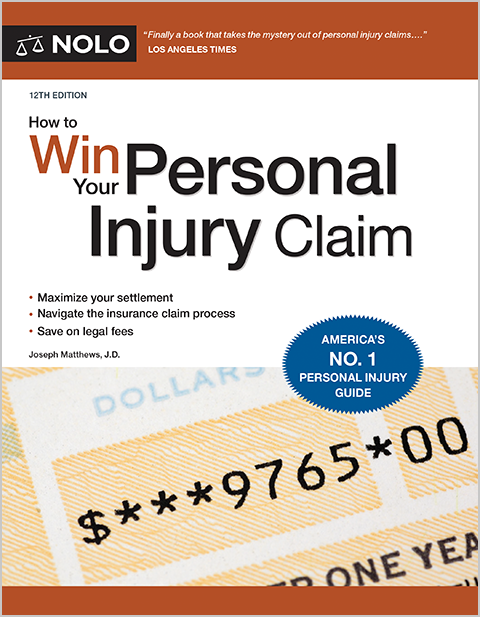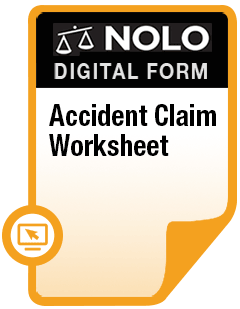A detailed discussion of how you prove the elements of your slip and fall claim, including the property owner's liability and your injuries and damages.
Slip and fall accidents account for over a million emergency room visits in the U.S. each year, according to the National Floor Safety Institute. If you're thinking about making an injury claim after a slip and fall, here's what you need to know:
- A property owner, business owner or someone else might be legally responsible for your accident, but that's not the case with every slip and fall.
- Proving a slip and fall case usually means showing that someone—like a property owner or store owner—was somehow negligent.
- Whether the defendant (the party you're suing) was negligent often focuses on whether they had notice of a dangerous condition, and whether their response to it was reasonable.
We start with the basics of slip and fall law. From there, we'll explain the impact your own negligence can have on your case, how to prove the elements of your slip and fall claim (including injuries and damages), the pros and cons of bringing a slip and fall lawsuit, and much more.
The Basics of Slip and Fall Law
Property owners, occupiers, and others who control real estate—we'll simply call them "owners" or "property owners" for the sake of convenience—have a legal obligation to make sure their property is reasonably safe for guests, customers, and other visitors. The law calls this obligation a "legal duty" or a "duty of care." When a property owner fails to meet this duty of care, it's called negligence.
Here's where things start to get more complicated. In any negligence claim, including slip and fall cases, duty of care is a two-way street. Property owners have a duty to make their property safe for foreseeable visitors. But visitors to a property also have a duty to look out for their own safety. We start with the property owner's duty of care.
What Is the Property Owner's Duty of Care?
The duty of care is a legal rule that tells property owners what they should do to make their property reasonably safe. It's determined by the law of the state where the property is located. Specific duty of care rules often vary significantly from one state to the next.
Generally speaking, the duty of care requires a property owner to:
- periodically inspect their property for dangerous conditions, and
- either warn visitors about those conditions or fix the danger so it won't cause injuries.
To find out about the duty of care and slip and fall laws in your state, speak to an experienced lawyer. Also, you can learn more about slip and fall claims against the government, stores and businesses, your landlord, or a homeowner.
Proving a Violation of the Property Owner's Duty of Care
Proving that a property owner violated ("breached," in legalese) the duty of care means showing that:
- there was an unsafe condition on the property
- the property owner knew or, in some cases, should have known of the danger, and
- the owner didn't adequately warn about the danger or take necessary steps to fix it.
When all three of these things are true, it means the property owner was negligent. If you prove the property owner's negligence caused you to suffer an injury, you've proved all the elements of a slip and fall claim.
Step One: Was There an Unsafe Condition on the Property?
It's not enough that you slipped or stumbled on someone else's property. To hold a property owner liable (legally responsible), your fall must have been caused by a dangerous condition on the property.
Examples of dangerous conditions include:
- uneven surfaces caused by something like a crack or break in the pavement or walkway
- loose or easily movable surface material such as gravel, rocks, or sand
- wet, slushy, snowy, or icy walkways
- stair runs or risers that are larger or smaller than what's typically required by building or safety codes
- torn, frayed, or unsecured carpets or rugs
- accumulations—natural or artificial—of water, snow, or ice
- foreign substances like liquids, foods, or other slipping or tripping hazards on floors
- aisles or walkways occupied or partially blocked by product displays
- tools or equipment left in aisles or walkways
- products spilled on store aisles
- inadequate lighting
- missing or defective railings, handrails, or guardrails, and
- things hanging from shelves or ceilings.
Once you've shown there was a dangerous condition on the property, you must prove that the property owner knew (or in some cases, should have known) about it.
Step Two: Proving the Property Owner Knew of the Danger
Proving the property owner knew about a dangerous condition is critical to a slip and fall claim. In most cases, the property owner will deny having had any knowledge of the danger, or will deny having learned of it in time to warn about or fix it before you were hurt.
Property owner's actual knowledge. In any slip and fall case, a property owner's actual knowledge (also called actual notice) of a dangerous condition will suffice. But proving what a property owner actually knew can be difficult.
When the property owner or their employees created the danger, that should be enough to prove actual knowledge. Otherwise, you'll need to look for evidence of actual knowledge such as:
- prior incident reports and complaints, documenting earlier encounters with the condition
- maintenance records, showing prior efforts to deal with the condition
- inspection reports from government agencies, recording prior infractions or safety violations related to the condition
- surveillance photos or videos, to prove how the condition came to be and how long it had existed
- testimony from others who saw the dangerous condition, to find out what they saw and what, if anything, they reported to the landowner
- emails, text messages, and other communications indicating that the dangerous condition was known to the property owner or its employees
- testimony from the property owner and its employees to find out what they knew about the condition and when they knew it, and
- expert witness testimony, which can help to establish, for example, how long a substance likely had been on the floor before you fell on it.
Property owner's constructive knowledge. In some slip and fall cases, the law will treat a property owner as having known about a danger even if they didn't actually know about it. The law calls this constructive knowledge or constructive notice. A property owner has constructive notice of a hazardous condition when there were enough available facts that the owner should have known about it, had they been reasonably careful and done an investigation.
The key to constructive knowledge is proving how long a dangerous condition existed before it injured you. In terms of owner responsibility, the longer it was there, the better. Once you have an idea of how long the danger existed, you can argue that had the property owner been reasonably careful, they would have inspected the property, discovered the hazard, and fixed it or warned you about it.
Step Three: Reasonable Steps to Warn About or Fix the Danger
So, you've proved there was a dangerous condition that was known to the property owner. Now you must prove that the owner didn't take reasonable steps to fix the danger or, if there wasn't time to fix it, to warn you about it.
To decide whether a property owner acted reasonably, the law focuses on regular and adequate efforts to keep the property safe and free of hazards. Here are some initial questions to ask:
- Does the property owner have a regular procedure for examining, maintaining and repairing the premises? If so, what proof does the owner have of this routine, and whether it was followed in the hours or minutes before your fall?
- If you tripped over or slipped on an object, was there a legitimate reason for the object to be there? Could it have been removed, covered, or otherwise made safe, without much inconvenience or expense?
- Could a simple barrier have been created or a warning been given?
- Did poor or broken lighting—usually an easy fix—contribute to the accident?
You Have a Duty of Care, Too
In almost every case, your conduct in the moments leading up to the fall will come under scrutiny. Why? Because as mentioned above, you have a duty to look out for your own safety. Property owners can raise several defenses that call into question whether your own carelessness caused the fall, in whole or in part.
Specifically, a defense called "comparative negligence" or "contributory negligence" appears in almost every slip and fall case, and it often succeeds. The defendant will claim that you were negligent because:
- you were somewhere on the property where visitors aren't allowed or aren't expected
- you didn't pay attention to where you were going
- you were distracted by something—your phone, a child, or anything else
- your footwear was inappropriate or unsafe, and
- the property owner adequately warned you of the danger, or took reasonable steps to fix it, but you were hurt anyway.
Most states follow the comparative negligence rule. Under this rule, your share of the fault simply reduces the compensation ("damages") you can collect—but only if you weren't mostly to blame (50% or more) for your fall.
A tiny handful of states—Alabama, Maryland, North Carolina, and Virginia, along with the District of Columbia—follow the draconian contributory negligence rule. In these places, any negligence on your part—even one percent of the total—wipes out your claim entirely. You're not allowed to recover any damages, no matter how serious or disabling your injuries might be.
The Pros and Cons of a Slip and Fall Lawsuit
As you weigh bringing a slip and fall lawsuit, consider the pros and cons of your decision. There's little downside to filing an insurance claim and trying to reach a settlement. But the same isn't true if settlement talks fail and you decide to sue.
The Pros
Let's be real: If you and your lawyer decide it's a good idea to sue, it's because you think you can get more money than you will by settling before you file. There aren't many other upsides to filing a lawsuit, and certainly none that matter as much as a bigger payoff.
A lawsuit ups the ante for all involved—you, your lawyer, the property owner, and the owner's insurance company. Because the risks go up, so too do the possible rewards. Insurance companies and their attorneys often will pay more for your claim just to avoid the tens of thousands they'll pay in litigation expenses. Unfortunately, the insurer might not be willing to offer much more until you (or your lawyer) have paid out tens of thousands in case expenses, too.
Your case will probably settle, because nearly all cases do. And chances are it will settle for more than what you were offered before you filed in court. Try to be patient, and give your lawyer enough room to do what you hired them to do—maximize the value of your recovery.
The Cons
Any experienced trial lawyer will tell you that filing a lawsuit should be your last resort. There's good reason for this advice: Litigation poses lots of risks. When you file a lawsuit, you're effectively saying to the judge and jury "We can't resolve this dispute ourselves. We need you to do it for us." One way or another your problem will get resolved, but the resolution might not be to your liking.
Here are some of the most significant downsides to filing a lawsuit.
Lawsuits Are Expensive
From the moment you file your case in court (likely a $200 to $400 filing fee), the case expense meter starts running. Make no mistake: Lawsuits cost lots of money. Here's a partial list of some common expenses in a run-of-the-mill slip and fall lawsuit:
- lawyers' fees (though you probably can find counsel who will take your case for a percentage of your recovery, called a contingency fee)
- court reporter fees and transcript costs for depositions and trial testimony
- expert witness fees
- travel, meals, and lodging for lawyers, experts, and other witnesses, and
- copies and administrative expenses.
So, what's the total tab likely to be? For a routine, uncomplicated slip and fall case, don't be surprised if the total case expenses are $20,000 or more. You and your lawyer will need to think long and hard about whether the potential lawsuit payoff will be worth this financial risk.
Lawsuits Take Time
File a lawsuit and chances are your case won't get to trial for a year, maybe more. If you're in a hurry to get paid, a lawsuit won't be your best option. And you might be in desperate need of money—something you can bet the insurance company will use to its advantage.
Now, let's assume you try your case to a jury and get a big verdict. Don't start spending that money right away, because odds are the defendant will appeal. It'll probably take eight months to a year to get a ruling from the court of appeals. More bad outcomes are possible here. For instance, the appellate court could take your verdict away, sending the case back to the trial court for a new trial.
Your lawyer can give you the specifics for your state, but here's a handy rule of thumb: If you plan to sue, make sure you have the wherewithal to sit tight for one to two years, maybe longer. Yes, the case might settle at any point along the way. Or it might not.
Lawsuits Are Stressful
Because so much is on the line, lawsuits tend to be very stressful. And the process of a lawsuit likely will add to your levels of stress and anxiety. Shortly after filing, a process called "discovery" begins. As the name suggests, discovery gives the parties a chance to find out—to discover—the facts and legal arguments their opponents will rely on if the case goes to trial.
During discovery, you'll have to sit for a deposition. During this oral question and answer session, the other side's lawyer gets to ask you questions that you must answer under oath. Everything gets recorded by a court reporter. Depositions and discovery force you to relive painful experiences that you'd just as soon forget, which can be unpleasant.
Before you sue, consider the impact the case might have on your mental and emotional health. There's no shame in settling if you think that's the best outcome for your psychological well being.
Don't Forget About Damages
While our focus has been on liability, don't forget about your injuries and other losses. Be prepared to prove these specific personal injury damages.
- Medical expenses. Hospital, surgical, pharmacy, and other medical expenses can be proved with your medical records and bills.
- Lost income. Past lost income or wages will be documented via your employer's personnel records, or perhaps a letter from the employer summarizing the amounts you lost. If you're asking for future lost wages too, your lawyer will have to get expert witnesses involved to calculate how much you're owed.
- Medical equipment. Records from your medical equipment provider will show the cost of crutches, a wheelchair, or a walker.
- Replacement services. Be sure to keep written records of amounts you pay for replacement lawn care, housecleaning, and similar services. Copies of cancelled checks should suffice.
- Pain and suffering and other intangibles. You won't have receipts to prove the value of your pain and suffering, emotional distress, disability, lost enjoyment of life, and other intangible losses. You'll need witnesses to testify about these things. Your lawyer will guide you through the process.
Get the details on how to determine the value of a slip and fall case.
Do You Need a Lawyer for a Slip and Fall Claim?
Yes, probably so. Are there some slip and fall claims you can handle on your own? Sure. You might get a fair settlement if your injuries are minor, there's no dispute over who was to blame, the claim isn't complicated by tricky legal issues, and you're comfortable fighting for the result you want.
Unfortunately, your case probably isn't so straightforward, because most slip and fall cases aren't. There's no substitute for an experienced personal injury lawyer who can:
- give you an honest assessment of the strengths and weaknesses of your claim and your injuries
- handle negotiations with insurers and the other side's lawyers
- prepare and file your case in court
- do much of the legwork during discovery
- take care of pretrial matters like motions and jury instructions
- help you to find facts and prepare a case narrative that puts you in the best possible light, and
- handle your trial and, if necessary, any appeals.
Remember that as a rule, you only get one chance to present your case in court. Don't take needless chances by going it alone. When you're ready to get help, here's how to find an attorney who's right for you.


